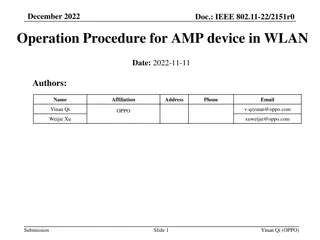Understanding the Significance of Energy Harvesting Devices
Energy harvesting devices play a crucial role in powering wireless sensor networks for various applications such as air quality monitoring, forest fire detection, and machine health monitoring. By utilizing energy sources like piezoelectric, thermoelectric, and solar technologies, these devices enable the collection of energy from ambient sources, providing sustainable power solutions for diverse industries.
Download Presentation

Please find below an Image/Link to download the presentation.
The content on the website is provided AS IS for your information and personal use only. It may not be sold, licensed, or shared on other websites without obtaining consent from the author. Download presentation by click this link. If you encounter any issues during the download, it is possible that the publisher has removed the file from their server.
E N D
Presentation Transcript
EECS 373 Energy Harvesting David Cesiel Jakob Hoellerbauer Shane DeMeulenaere University of Michigan *
Outline Why are Energy Harvesting Devices Important? Energy Sources Available Energy Harvesting Devices Comparison of Devices Power Storage *
Why are Energy Harvesting Devices Important? Wireless Sensor Networks Autonomous sensors monitoring physical or environmental conditions Pass data through network back to a main location *
Uses for Wireless Sensor Networks Air Quality Monitoring Forest Fire Detection Landslide Detection Machine Health Monitoring o Sense when machines need to be serviced Water Quality Monitoring Monitoring Soil for Agriculture Structural Monitoring o Checking loads and vibration on bridges Home Monitoring *
Energy Sources Piezoelectric Thermoelectric Solar *
Piezoelectric Energy Harvesting Uses materials, usually crystals, that accumulate charge under stress This can be used to convert movement into power Can achieve power conversion efficiency of nearly 90%
Piezoelectric Energy Harvesting Could be used: o To generate power from human motion Shoes Clothing Wrist Watches TV Remote Controls o Seismic Vibration Train station walk ways o To harvest power from acoustic noise o To power sensors Sensors that detect wear on industrial robots
Thermoelectric Energy Harvesting Converts temperature differences to electric voltage using the thermoelectric effect. This effect occurs when one end of the device is at a different temperature then the other. Temperature change causes charge carriers in the thermoelectric material to diffuse from one end of the conductor to the other Maximum efficiency of ~10%
Thermoelectric Energy Harvesting Could be used: o For heat recovery on vehicles o To power consumer electronics through body heat o Sensors
Photovoltaic (Solar) Converts solar radiation into power using semiconductors that exhibit the photovoltaic effect o Materials such as Monocrystalline Silicon, Polycrystalline Silicon and Amorphous Silicon Maximum efficiency of current solar energy harvesters is ~40%
Energy Harvesting Power Managers Step up/Rectify input voltage source Store Energy in Battery/Capacitor/SuperCap Output Regulated power to MCU/Radios/etc Signal MCU when power is available Many ICs available from companies like TI, Maxim Integrated and Linear Technology
Trade-offs Minimum Startup Voltage Idle (quienscent) current Minimum charging voltage Storage types (Battery/Capacitors) Energy Source Types Output voltage(s)
Texas Instruments - BQ25504 Cold Start Startup Voltage: 330mV Charging Voltage: 80 mV Quiescent current: <330nA (typical) Storage Types: Batteries, Caps, Supercaps Output Voltages: 2.5V - 5.25V Energy Sources: Broad(Solar, TEG, Piezoelectric, etc..)
LTC3108 Startup Voltage: 20mV Idle (quiescent) Current: 0.2 A Charging Voltage: 20 - 500 mV Storage Types: Capacitor Energy Source Types: Thermoelectric and Solar Output voltage(s): 2.35V, 3.3V, 4.1V or 5V
LTC3109 Startup Voltage: +-30mV Idle (quiescent) Current: 0.2 A Charging Voltage: +- 30 +- 500 mV Storage Types: Capacitor or Battery Energy Source Types: Thermoelectric or Solar Output voltage(s): 2.35V, 3.3V, 4.1V, 5V
LTC3588-1 Startup Voltage: 2.7V Idle (quiescent) Current: 950nA Charging Voltage: 2.7-20V Storage Types: Capacitor Energy Source Types: Piezoelectric, any AC Output voltage(s): 2.35V, 3.3V, 4.1V or 5V
MAX17710 Startup Voltage: 0.75 V Idle (quiescent) Current: 625nA Charging Voltage: 0.75 - 5.3 V Storage Types: Micropower-storage cells Energy Source Types: Anything Output voltage(s): 1.8V, 2.3V, 3.3V
Best Components Low Power: BQ25504 or LTC3108 AC sources: LTC3588-1 or LTC3109
Why is Power Storage Necessary? Energy Harvest sources will not always be able to generate current Solar cells: at night, there is no light Piezoelectric: there will not always be motion thermoelectric devices: there will not always be a suitable temperature gradient
Li-Ion/Li-polymer Batteries Can be made extremely small Li-Po batteries are more often used for energy harvesting systems because they have a very high discharge to charge efficiency (greater than 99 % compared to less than 90 % for standard Li-ion) One drawback is that Li-ion/Li-polymer batteries have to be charged very carefully. Overcharging could cause the battery to become unstable
Solid State Thin Film Batteries Are also Li-Ion batteries but the electrolyte is a solid Therefore, thin film batteries can be used at very low temperatures, down to -40 C Example: Infinite Power Solutions' (IPS) THINERGY Micro-Energy Cells o Near zero self-discharge current o about 100,000 recharge cycles o low internal resistance, so it can be charged by a very low-current source
Supercapacitors Another name for an electric double-layer capacitor (EDLC) Usually used for energy storage rather than in a circuit o Much higher energy density than regular capacitors o An EDLC has several orders of magnitude larger capacitance than a similar sized regular capacitor o Can only withstand low voltages Energy density is only around 1/10 that of a conventional battery Power density is generally 10 to 100 times greater
References http://www.ti.com/ww/en/apps/energy- harvesting/index.shtml?DCMP=MSP430_Energy&H QS=Other+OT+430energy http://www.infinitepowersolutions.com/images/s tories/downloads/controlled_documents/DS1012 .pdf http://www.digikey.com/us/en/techzone/energy- harvesting/resources/articles/storage-battery- solutions.html http://cds.linear.com/docs/Datasheet/3108fb.pdf http://cds.linear.com/docs/Datasheet/35881fa.pd f
References http://www.ti.com/product/bq25504 http://www.linear.com/product/LTC3108 http://www.linear.com/product/LTC3109 http://www.linear.com/product/LTC3588-1 http://www.maximintegrated.com/datasheet/index.mvp/id/7183























